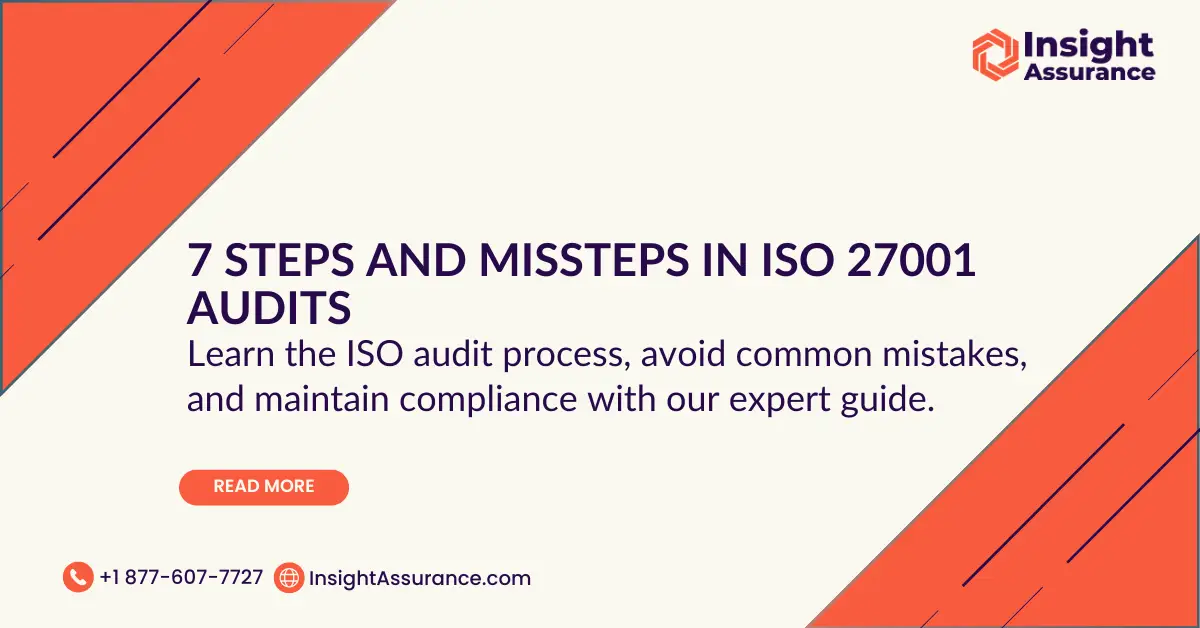Cyber threats and data breaches are increasing in both frequency and sophistication, posing significant risks to organizations of all sizes. ISO 27001, the internationally recognized standard for Information Security Management Systems (ISMS), offers a comprehensive framework for managing and protecting valuable information assets.
Achieving ISO 27001 certification enhances an organization’s credibility by demonstrating a committed adherence to stringent information security practices. Not only does it fortify your defenses against potential data breaches, but it also fosters trust among your clients, partners, and stakeholders. Moreover, integrating ISO 27001 standards into business operations streamlines processes and improves operational efficiency, contributing to overall business resilience.
To help organizations better prepare for compliance, we’ll be taking a comprehensive look at the ISO 27001 certification process, breaking it down into the seven steps to take and seven audit missteps to avoid.
What Are ISO 27001 Audits?
ISO 27001 audits are systematic evaluations conducted to assess an organization’s compliance with the ISO 27001 standard for information security management. These audits are designed to verify that an organization has implemented an effective ISMS that aligns with the standard’s requirements.
There are two primary types of ISO 27001 audits:
- Internal Audits: These are performed by the organization itself (or an appointed third party) to assess its readiness for certification. Internal audits help identify gaps or nonconformities in the ISMS so they can be addressed before the external audit.
- Certification Audits: Conducted by an accredited certification body, these audits determine whether the organization meets the ISO 27001 standard and can achieve internationally-recognized certification. Certification audits are typically divided into two stages to examine the documentation and practical implementation of ISMS.
ISO 27001 audits are essential for organizations aiming to demonstrate their commitment to information security, improve their risk management practices, and comply with legal and regulatory requirements.
The Benefits of ISO 27001 Compliance
Implementing the ISO 27001 standard provides organizations with a robust framework for managing information security risks. Achieving compliance offers several significant benefits that enhance both security posture and business operations, including:
Stronger Information Security
ISO 27001 compliance reduces the risk of cyber threats, data breaches, and unauthorized access by establishing comprehensive security controls. This proactive approach safeguards sensitive information and reinforces defenses against emerging threats.
Regulatory Compliance
Adhering to ISO 27001 assists organizations in meeting legal and industry-specific security requirements, such as the General Data Protection Regulation (GDPR).
Demonstrated Commitment to Security
Certification demonstrates a commitment to security best practices, building trust with customers, partners, and stakeholders. Organizations that achieve ISO 27001 compliance distinguish themselves in the marketplace by showcasing their dedication to protecting information assets.
Operational Efficiency
Implementing the standard can help streamline security processes and risk management strategies, improving operational efficiency. ISO 27001 promotes a systematic approach to information security management, leading to enhanced business resilience and alignment of security objectives with organizational goals.
Reduced Financial Risk
By preventing costly breaches and avoiding potential regulatory fines, ISO 27001 compliance effectively reduces financial risk. The standard’s emphasis on risk assessment and mitigation helps organizations avert expenses associated with security incidents.
Improved Incident Response
ISO 27001 provides a structured framework for identifying, managing, and mitigating security risks. Organizations benefit from established incident response procedures, enabling swift action when security events occur and minimizing potential impacts.
To fully realize these advantages, it is essential to understand the audit process in detail.
A Step-by-Step Guide to the ISO 27001 Audit Process
Achieving ISO 27001 certification involves a structured audit and implementation process. This guide walks you through each key phase for a smooth path to compliance:
Step 1: Define the Scope of Your ISMS
The first step in the ISO 27001 audit process is to define the scope of your ISMS. Identify which systems, assets, and business processes fall under ISO 27001 compliance. Clearly delineating the scope allows you to address all relevant areas and allocate resources efficiently. Establish security objectives aligned with business goals to provide direction and focus for your information security efforts.
Step 2: Conduct a Risk Assessment
Conducting a comprehensive risk assessment is crucial to understanding potential vulnerabilities. Use ISO 27005 or another recognized methodology to identify, evaluate, and prioritize risks to your information security. This involves assessing threats to assets, determining the likelihood of occurrence, and evaluating the potential impact. Implement risk treatment plans to address identified vulnerabilities, thereby mitigating risks and enhancing your overall security posture.
Step 3: Implement Security Controls
After identifying risks, implement appropriate security controls to mitigate them. Apply the applicable controls outlined in Annex A of the ISO 27001 standard to strengthen your security posture. Establish policies on access management, encryption, incident response, and business continuity. These controls and policies form the foundation of your ISMS, ensuring that security practices are embedded in daily operations.
Step 4: Develop Required Documentation
Documentation is a critical component of ISO 27001 compliance. Create comprehensive policies, procedures, and security records to demonstrate adherence to the standard’s requirements. Ensure documentation aligns with the Statement of Applicability (SoA), which outlines the controls selected and the justification for their inclusion or exclusion. Well-organized and thorough documentation facilitates the audit process and serves as a reference for ongoing information security management.
Step 5: Conduct an Internal Audit
Before the certification audit, perform an internal audit to assess the effectiveness of your ISMS. This self-assessment helps identify gaps or nonconformities that need to be addressed. Use an internal auditor or a third-party ISO 27001 consultant to review compliance with the standard’s requirements. Addressing issues uncovered during the internal audit enhances readiness for the external audit and increases the likelihood of successful certification.
Step 6: Undergo the Certification Audit
The certification audit is conducted by an external auditor from an accredited certification body and consists of two stages:
- Stage 1 Audit: Evaluates documentation and ISMS readiness. The auditor reviews your documented information to verify that all necessary policies, procedures, and records are in place and meet ISO 27001 requirements.
- Stage 2 Audit: Assesses the implementation of security controls and processes. The auditor examines how your ISMS operates in practice, ensuring that policies are effectively implemented and maintained.
Address any nonconformities identified by the auditor promptly to achieve certification. Demonstrating a commitment to resolving issues reflects positively on your organization’s dedication to information security.
Step 7: Maintain Compliance Through Continuous Improvement
Achieving certification is not the end of the process. You’ll also need to conduct regular risk assessments and update policies as needed to respond to evolving threats and changes within the organization. Schedule annual surveillance audits to retain certification and demonstrate ongoing compliance. Continuous improvement is a core principle of ISO 27001, promoting sustained enhancement of your information security management system.
7 Common Mistakes in ISO 27001 Audits (and How To Avoid Them)
Even well-prepared organizations can encounter challenges during the ISO 27001 audit process. Recognizing and addressing common pitfalls enhances the likelihood of successful certification. Here are a few critical mistakes to avoid, along with strategies to mitigate them:
1. Lack of Senior Management Support
Without active involvement from senior leadership, information security initiatives may lack direction and necessary resources. This oversight can hinder the implementation of an effective information security management system.
Solution: Ensure that senior management is actively engaged in setting security objectives and allocating resources for compliance efforts. Leadership commitment reinforces the importance of information security and encourages a culture of compliance throughout the organization.
2. Poorly Defined Scope
An unclear or overly broad scope can complicate the audit process and lead to unmanaged expectations. Failing to precisely define the boundaries of the ISMS may result in overlooked assets or processes.
Solution: Clearly document which systems, assets, and business processes are included in your ISO 27001 certification. A well-defined scope prevents scope creep and addresses all relevant areas during the audit.
3. Incomplete Risk Assessments
An inadequate risk assessment can leave vulnerabilities unidentified, undermining the effectiveness of the ISMS. This gap may lead to nonconformities during the audit.
Solution: Conduct a comprehensive risk assessment, documenting each identified risk and its treatment plan. Utilize established methodologies like ISO 27005 for a thorough evaluation of potential threats.
4. Insufficient Documentation
Disorganized or missing documentation can hinder the audit process and raise compliance concerns. Auditors require evidence of implemented policies and procedures to verify adherence to ISO 27001 requirements.
Solution: Maintain clear, well-organized policies, procedures, and audit records that align with the standard. Ensure all documentation is current and accessible to facilitate a smooth audit experience.
5. Failure To Train Employees
Employees play a critical role in maintaining information security. Lack of awareness or training can result in unintentional breaches or noncompliance with established protocols.
Solution: Implement regular security awareness training to ensure employees understand their responsibilities in maintaining compliance. Training should cover key policies, procedures, and best practices related to information security.
6. Delaying Internal Audits
Waiting too long to perform an internal audit can leave insufficient time to address identified issues before the certification audit. This delay may jeopardize the success of the certification process.
Solution: Conduct an internal ISO 27001 audit early to identify and resolve gaps. Early intervention allows for corrective actions to be implemented effectively, enhancing readiness for the external audit.
7. Neglecting Continuous Monitoring
Ignoring continuous monitoring can lead to lapses in compliance and erosion of the ISMS’s effectiveness over time. ISO 27001 emphasizes the importance of ongoing evaluation and improvement.
Solution: Regularly assess and update security controls, risk management policies, and compliance documentation. Schedule periodic reviews to ensure the ISMS adapts to evolving threats and organizational changes.
Understanding these common mistakes and proactively addressing them strengthens the organization’s security posture. Emphasizing continuous improvement and learning from past audits not only facilitates compliance but also contributes to long-term success in information security management.
Of course, the journey doesn’t end with certification. Next, we’ll explore a few strategies for sustaining compliance post-certification to ensure the ongoing protection of your most valuable information assets.
Maintaining ISO 27001 Compliance Post-Certification
Ongoing compliance and regular surveillance audits are crucial to maintain certification and ensure continuous protection of sensitive information. Engaging in periodic evaluations reaffirms the organization’s commitment to information security and helps identify areas for improvement.
Integrating ISO 27001 practices into daily operations is essential for sustaining compliance. This involves embedding security controls and procedures into the organization’s culture and routine activities. By making information security an integral part of business processes, organizations can enhance operational efficiency and effectively manage risks associated with data breaches and cyber threats.
Management reviews play a pivotal role in sustaining compliance. Senior leadership must regularly assess the performance of the ISMS to ensure it aligns with organizational objectives and responds to evolving risks. These reviews facilitate strategic decision-making regarding resource allocation, policy adjustments, and improvements to security practices.
Employee training is another critical component of maintaining ISO 27001 compliance. Ongoing education ensures that staff remain aware of their responsibilities and are equipped to follow established information security policies and procedures. Regular training sessions reinforce the importance of security practices and contribute to a culture of compliance within the organization.
By prioritizing continuous improvement and vigilance, organizations can not only retain their ISO 27001 certification but also strengthen their overall security posture. This sustained commitment to information security supports long-term organizational growth and resilience in the face of emerging threats.
Achieve ISO 27001 Certification With Confidence
ISO 27001 compliance can be complex, but you don’t have to navigate it alone.
Insight Assurance offers expert ISO 27001 audit support, readiness assessments, and compliance guidance to help organizations achieve certification with confidence. Our team of seasoned professionals is committed to simplifying compliance and empowering your organization to achieve its security objectives efficiently and effectively.
Contact Insight Assurance today to streamline your ISO 27001 journey and secure your business’s future.


